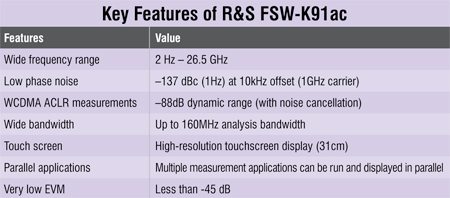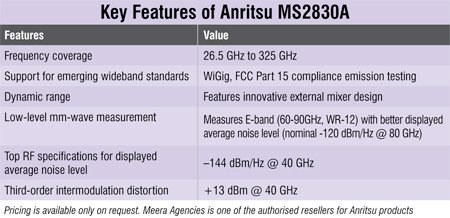If you plan to upgrade your test lab, you would like to get the latest spectrum analyser available in the market. This article talks about the latest cutting-edge spectrum analysers that are out in the market, covering their pricing, new technology and improved functionality
DILIN ANAND
There are general-purpose spectrum analysers, and then there are specialised ones. What kind of a spectrum analyser do you need? The answer to this question basically depends on the maximum frequency range that you want to measure, after including the harmonics and intermodulation products of the wanted signals. Although you can get a lab-grade oscilloscope that can analyse low audio frequencies up to microwave, this is overkill if you are going to use it with audio equipment. On the other hand, if you are working on very high frequencies, you might need an analyser that has a resolution good enough to differentiate between the smaller frequencies.

Some new releases in this space are:
1. Tektronix MDO4000 mixed-domain oscilloscope, which is claimed to be the world’s first oscilloscope with built-in spectrum analyser.
2. R&S FSW-K91ac signal and spectrum analyser, which supports the new IEEE 802.11ac WLAN standard.
3. Anritsu MS2830A + OML MxxHWD, which has a frequency coverage of up to 325 GHz.
4. Agilent N9344C HSA—an MIL PRF 28800 Class 2 compliant handheld spectrum analyser.
5. Scientech DSA800 Series spectrum analyser, which comes with a wide-screen display and is targeted at hobbyists.
The innovative lot includes:
1. Aronia X-Series USB RF spectrum analyser. Featuring specifications and performance similar to the equivalent Spectran handheld spectrum analysers, these RF spectrum analysers are controlled entirely via the USB interface using the real-time RF analysis software included with every unit.
2. Metageek WiSPY DBX—a pocket-sized tool designed for enterprise-level troubleshooting of WiFi environments. It has an amplitude range of –6.5 dBm to –100 dBm and amplitude resolution of 0.5 dBm. The device features an RP-SMA antenna too.
Purchasing an instrument for spectrum analysis being a major investment, make sure that you buy one that not only meets your today’s requirements but can also cope-up with the demands of tomorrow. With this in mind, selecting the ideal instrument should be a well-thought-out affair, with sufficient inputs from the people who are going to use it. Here are some pointers.
1 Working with the IEEE 802.11ac WLAN standard?
If your project requires you to work with the upcoming 802.11ac WLAN standard, go for an analyser that is capable of analysing these signals. Although 802.11ac is still being defined, companies that chair the WiFi alliance have already brought out their own solutions using this standard.

The new standard requires 256 quadrature amplitude modulation (QAM), up to eight MIMO data streams, and a higher frequency band, along with wide bandwidths of up to 80 MHz. (The 160MHz bandwidth in this standard is achieved by using 80+80MHz mode.) Moreover, due to the 256 QAM, this standard requires an error vector magnitude (EVM) of -32 dB. The R&S FSW-K91ac tool features a very low EVM of less than -45 dB.
Announced on 20th June this year from Munich, the FSW-K91ac option enables the R&S signal and spectrum analyser to record and demodulate the full bandwidth of a WLAN signal in line with the new standard. It has a 31cm (12.1-inch) touchscreen with MultiView. MultiView provides users with simultaneous view of multiple measurements and applications. Pricing is available only on request.
2 Spectrum analysers for education and hobbyists
Spectrum analysers for educational use and hobbyists should not only let them experiment with measurement testing but also act as a standard industrial instrument.
The DSA800 series from Scientech includes compact, light-weight and low-cost spectrum analysers that suit the education and hobbyist applications. The digital IF technology of this series helps in radio frequency (RF) applications like measurement of an RF amplifier’s characteristics, measurement of an RF bandpass filter’s characteristics, and measurement of voltage standing wave ratio.

The analysers offer a minimum resolution bandwidth of 100 kHz and are available with or without tracking generator. Their widescreen display, advanced measurement functions, electromagnetic interference (EMI) filter and quasi-peak detector kit, up to -135dBm displayed average noise level, phase noise of -80 dBc/Hz at 10kHz offset, total amplitude uncertainty of less than 1.5 dB, and the capability to interface through LAN, USB host, USB device and GPIB make them suitable for a majority of education and hobbyist applications.
The series comprises spectrum analysers to be used in basic electronics, basis communication, antenna and wireless communication labs.
3 Millimetre-wave analysers
Millimetre-wave (mm-wave) analysers are intended for spectrum and signal analysis of emerging wideband communication systems. Using new capabilities, engineers can evaluate, characterise and manufacture products designed for emerging wideband standards, such as WiGig, including FCC Part 15 compliance emission testing requirements from 40 GHz to 200 GHz.

The MxxHWD harmonic mixer, based on a single-diode design, is available in waveguide bands from 26.5 GHz to 325 GHz. The harmonic mixer is a two-port frequency extension product with mm-wave interface for device-under-test (DUT) connection. The Anritsu MS2830A signal analyser, when coupled with the OML MxxHWD harmonic mixer, offers mm-wave frequency coverage from 26.5 GHz to 325 GHz.






